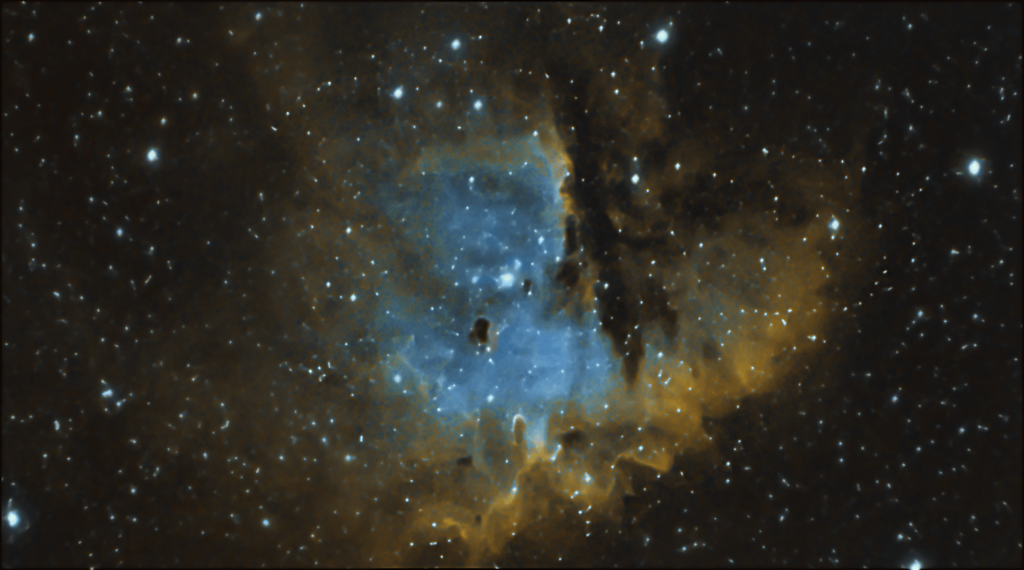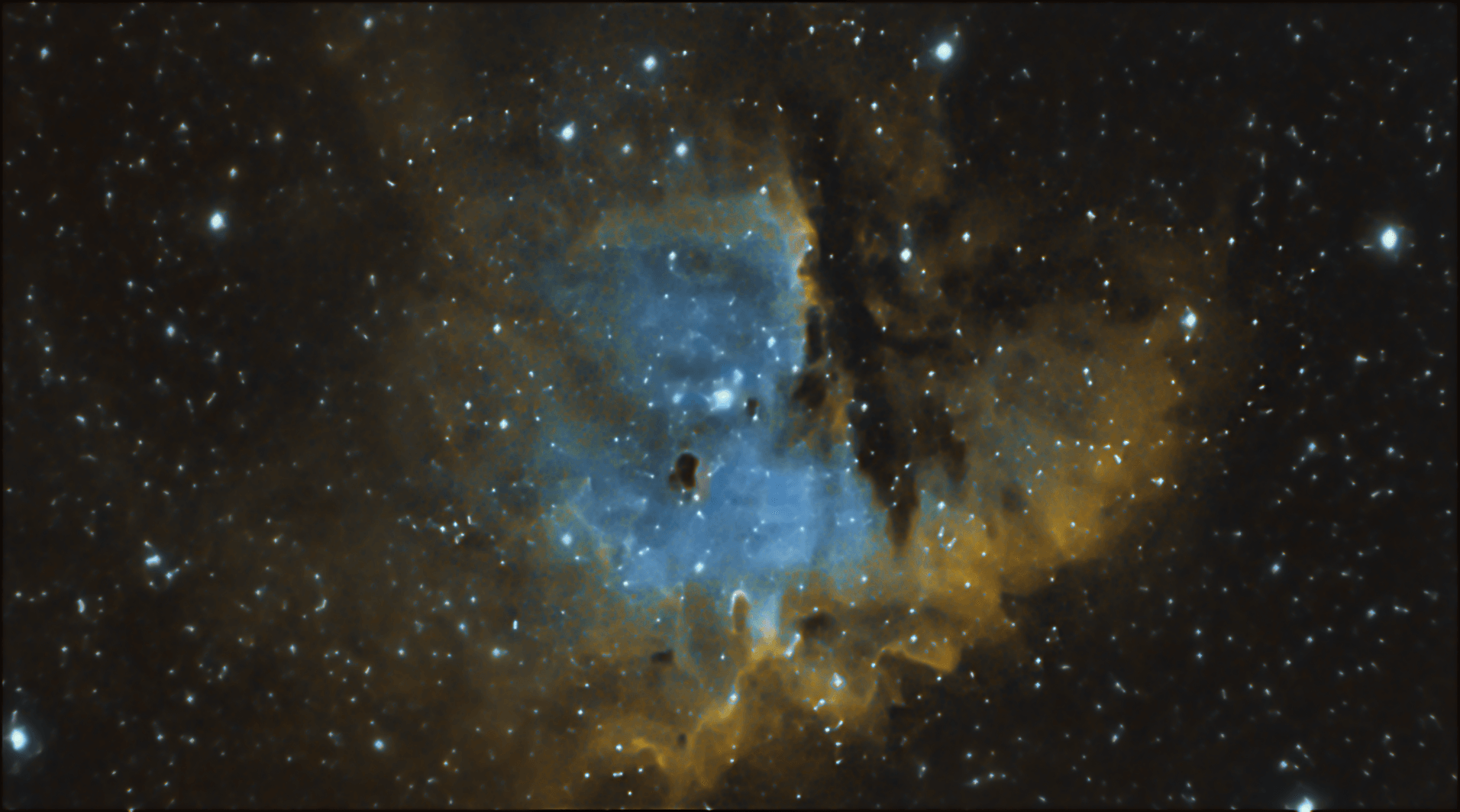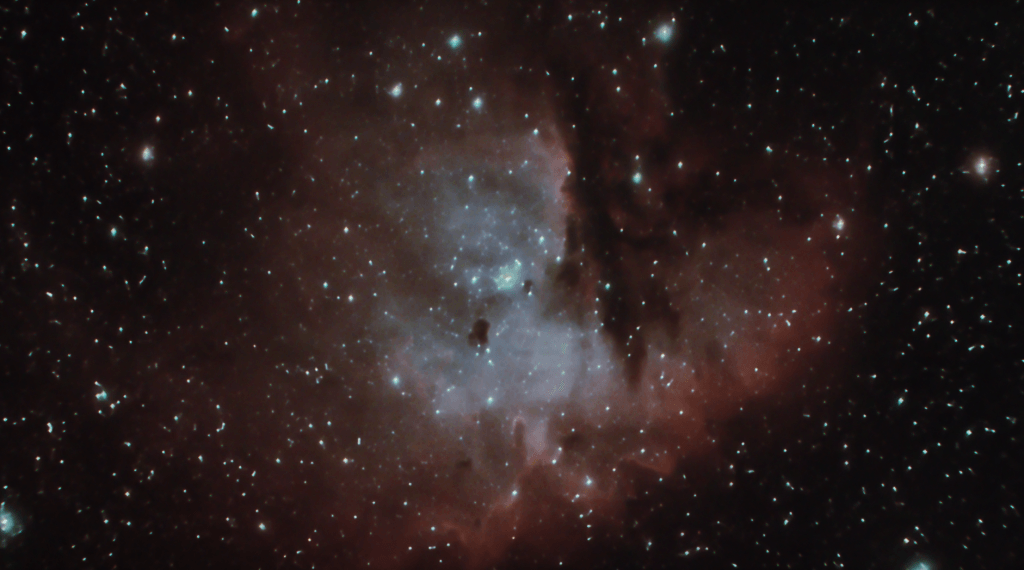This is my false-colour astrophotograph of the Pac-Man Nebula NGC 281. My original ‘natural-colour’ version is here. I used a ‘pseudo Hubble Palette’ to assign the different spectral lines of nebulae emission to different colours. The Hubble Palette arbitrarily assigns the frequency of the SII spectral line of sulphur to red, the OIII spectral line of oxygen to blue, and the Hα (hydrogen alpha) spectral line of hydrogen to green. Each spectral line must usually be captured using a narrowband filter (one each for SII, OIII and Hα for the Hubble Palette).
For this image, I collected data with the quad-band one-shot colour (OSC) filter from Altair. This OSC filter isolates the primary nebulae emission wavelengths, passing both Hβ (hydogren beta) and OIII together through one 35-nm-wide ‘zone’ to be captured by the blue and green pixels, and also both Hα and SIII together through another 35-nm-wide ‘zone’ to be captured by the red pixels. As all other wavelengths are blocked, it is a very effective technique to block out light pollution.
Obviously, since I used a OSC filter and not narrowband filters, I could not directly create a true Hubble Palette image; however, a ‘pseudo Hubble Palette’ is still possible by carefully mixing channels. I used Photoshop to separate out the RGB (red, green and blue) channels, and then processed each channel separately (mainly just stretching the histogram and setting the background level). I then assumed the R channel represents Hα and SII combined, the G channel represents OIII, and the B channel represents Hβ, as per the image below (which is approximate as the red, green and blue pixels of every camera will be sensitive in slightly different ranges).

Guided by the conventional Hubble Palette, I then assigned the combined Hα+SII signal to both the red and green channels equally, and the OIII signal to just the blue channel. At this point, the image already has a distinct Hubble Palette ‘flavour’ to it. I hadn’t, however, used the Hβ signal yet, and didn’t want to waste the data, even though Hβ is not part of the Hubble Palette and seems rarely used for astro imaging. I thought that Hβ would represent a low strength version of the Hα signal, and so used the Photoshop channel mixer to set the G channel (due to the combined Hα+SII signal) to 80% and overlaid the extra Hβ signal in the green channel only with an opacity of 20%.
To complete the look, I adjusted the RGB histograms separately, boosted the vibrance, and selectively sharpened and smoothed. Since this is not a genuine Hubble Palette image that can be used to identify regions of SII, OIII and Hα, it perhaps begs the question, ‘What’s the point?’ It’s a reasonable question, to which I answer: (1) I find this false-colour rendition beautiful and capturing beautiful photographs of the universe is for me, a large part of what this hobby is about; and (2) comparing this image with the ‘natural-colour’ version shown below, this false-colour version reveals more of the details, so perhaps does serve a functional purpose too.
Frames
- 130× 130-s light frames
- 32× dark frames
- 35× flat frames
- 42× dark flat frames
- 115× bias frames
Equipment
- Explore Scientific ED 102 mm Apo f/7 refractor
- Sky-Watcher EQ5 PRO SynScan GOTO equatorial mount
- Altair GPCAM3 290C colour camera (with UVIR window fitted) and 0.5× reducer
- Altair quad-band one-shot colour (OSC) 2″ filter
- Altair 60mm guide scope
- Altair GPCAM2 AR0130 mono guide camera
Software
- Sharpcap
- PHD2
- DeepSkyStacker
- Photoshop



